Do you have a question about the Daikin FVXM25YVMA and is the answer not in the manual?
Records preferred temperature and airflow for easy recall.
Save up to 4 timer settings daily for personalized schedules.
Dries the indoor unit to prevent mold generation.
Decomposes mold and allergens for cleaner air.
Optimizes convection by distributing hot air from the bottom.
Reduces outdoor unit noise for a quieter neighborhood.
Instructions to avoid injury, loss of life, or property damage.
Guidelines for unit placement and operational environment.
Details of the indoor unit's signal receiver and lamps.
Description of vertical blades (louvres) and horizontal blade (flap).
Identification of streamer air inlet and main air outlet.
Location of temperature and humidity sensors.
Explanation of DAIKIN EYE, MOLD PROOF, and TIMER lamps.
Location and function of the indoor unit's ON/OFF switch.
Function of the streamer unit for mold and allergen reduction.
Location of the air filter and deodorizing filter.
Identification of outdoor unit's air inlet, outlet, sensor, pipes, and drain hose.
Overview of the LCD display and main control buttons.
Explanation of POWERFUL, HEAT PLUS, and LAN buttons.
Description of ON/OFF, Temp, and Fan setting buttons.
Controls for mode selection, HOME LEAVE, and ECONO/QUIET.
Controls for SWING, FLOOR WARMING, and MENU operations.
Controls for OFF TIMER, TIMER CANCEL, and SELECT.
Button for setting the clock.
Functionality and setup of the wireless LAN adapter.
Required items for smart control setup.
Important notes regarding potential interference and safety.
Instructions for using voice commands with smart assistants.
Safety guidelines for battery insertion and handling.
Steps to mount the remote controller holder on a wall.
How to attach separately sold deodorizing filters.
Instruction to turn on the circuit breaker before operation.
Step-by-step guide to setting the unit's internal clock.
Adjusting display brightness or turning it off.
How to set automatic or manual air outlet direction.
How to select and start different operation modes.
Procedure to stop the air conditioner.
Important notes for AUTO, COOL, DRY, HEAT, and FAN modes.
How to adjust the target temperature for different modes.
Recommendations for efficient use and saving energy.
How to enable or disable the dry keep feature.
Steps to change the fan speed and quiet operation settings.
How to start and stop the automatic swing feature.
How to adjust vertical louvres manually.
Important considerations for airflow direction settings.
How to activate and cancel floor warming mode.
Steps to operate the mold proof function automatically.
Details on automatic operation, limitations, and conditions.
How to set and activate the streamer air cleaning function.
How to start and cancel the Home Leave function.
Details on when Home Leave can be used and its limitations.
Examples of using Home Leave for energy saving and favorite modes.
How to activate and cancel Powerful and Heat Plus modes.
Information on the effects and limitations of Powerful mode.
Possible combinations with other operations and notes.
How to start and cancel ECONO and Quiet modes.
Information on performance and limitations of these modes.
How to set and cancel the 24-hour ON timer.
How to set and cancel the 24-hour OFF timer.
How to combine ON and OFF timers.
How to use the remaining hours display for timers.
How to use different timer display modes together.
Overview of setting the weekly timer for daily schedules.
Step-by-step guide to setting weekly timer reservations.
How to set the time and temperature for weekly reservations.
How to copy timer settings to other days of the week.
How to view existing weekly timer settings.
How to disable the weekly timer function.
How to remove a specific timer reservation.
How to delete all reservations for a specific day.
How to clear all saved weekly timer settings.
Overview of connecting the adapter to a home network.
Steps to install the DAIKIN Mobile Controller app.
Options for connecting the adapter to the network (WPS/AP).
How to check the adapter's connection status via the unit.
Meaning of different DAIKIN EYE lamp behaviors for LAN status.
Steps to activate the wireless LAN adapter.
Steps to deactivate the wireless LAN adapter.
How to connect using WPS on the router.
How to connect without WPS using an access point.
How to reset to factory defaults.
Overview of cleaning parts like air inlets, filters, and panels.
Methods and schedule for cleaning/replacing deodorizing filters.
Guidelines for air quality and dust collection filters.
Steps to access and remove the front panel.
How to remove and reinstall the air filters.
Instructions for cleaning filters with water or vacuum.
Steps to reattach and close the front panel securely.
How to attach and insert various filter types.
Detailed instructions for cleaning/replacing filters.
Effects of dirty filters and disposal of old filters.
Steps before a long period of non-operation.
Advice on professional maintenance and costs.
Common issues and their explanations.
Explanations for various operational sounds.
Reason for delayed flap movement.
Explanations for water/steam from outdoor unit in different modes.
Reasons for low air temperature during HEAT PLUS operation.
Explanation for mist appearing from the indoor unit.
Troubleshooting for signal reception problems.
Causes for faint, non-working, or erratic display.
What to do if the remote controller's '7' blinks.
Troubleshooting for interference with other devices.
Causes and solutions for odors from the unit.
Reasons for dark display lamps.
Why the streamer discharge sound might stop.
What to do if the unit behaves strangely.
Troubleshooting for TIMER not operating as set.
Notes on conditions affecting operation and dew formation.
Handling issues with the wireless LAN adapter.
Warning and advice for serious issues like burning smell.
Regulations for unit disposal.
How to check error codes using the remote controller.
Records preferred temperature and airflow for easy recall.
Save up to 4 timer settings daily for personalized schedules.
Dries the indoor unit to prevent mold generation.
Decomposes mold and allergens for cleaner air.
Optimizes convection by distributing hot air from the bottom.
Reduces outdoor unit noise for a quieter neighborhood.
Instructions to avoid injury, loss of life, or property damage.
Guidelines for unit placement and operational environment.
Details of the indoor unit's signal receiver and lamps.
Description of vertical blades (louvres) and horizontal blade (flap).
Identification of streamer air inlet and main air outlet.
Location of temperature and humidity sensors.
Explanation of DAIKIN EYE, MOLD PROOF, and TIMER lamps.
Location and function of the indoor unit's ON/OFF switch.
Function of the streamer unit for mold and allergen reduction.
Location of the air filter and deodorizing filter.
Identification of outdoor unit's air inlet, outlet, sensor, pipes, and drain hose.
Overview of the LCD display and main control buttons.
Explanation of POWERFUL, HEAT PLUS, and LAN buttons.
Description of ON/OFF, Temp, and Fan setting buttons.
Controls for mode selection, HOME LEAVE, and ECONO/QUIET.
Controls for SWING, FLOOR WARMING, and MENU operations.
Controls for OFF TIMER, TIMER CANCEL, and SELECT.
Button for setting the clock.
Functionality and setup of the wireless LAN adapter.
Required items for smart control setup.
Important notes regarding potential interference and safety.
Instructions for using voice commands with smart assistants.
Safety guidelines for battery insertion and handling.
Steps to mount the remote controller holder on a wall.
How to attach separately sold deodorizing filters.
Instruction to turn on the circuit breaker before operation.
Step-by-step guide to setting the unit's internal clock.
Adjusting display brightness or turning it off.
How to set automatic or manual air outlet direction.
How to select and start different operation modes.
Procedure to stop the air conditioner.
Important notes for AUTO, COOL, DRY, HEAT, and FAN modes.
How to adjust the target temperature for different modes.
Recommendations for efficient use and saving energy.
How to enable or disable the dry keep feature.
Steps to change the fan speed and quiet operation settings.
How to start and stop the automatic swing feature.
How to adjust vertical louvres manually.
Important considerations for airflow direction settings.
How to activate and cancel floor warming mode.
Steps to operate the mold proof function automatically.
Details on automatic operation, limitations, and conditions.
How to set and activate the streamer air cleaning function.
How to start and cancel the Home Leave function.
Details on when Home Leave can be used and its limitations.
Examples of using Home Leave for energy saving and favorite modes.
How to activate and cancel Powerful and Heat Plus modes.
Information on the effects and limitations of Powerful mode.
Possible combinations with other operations and notes.
How to start and cancel ECONO and Quiet modes.
Information on performance and limitations of these modes.
How to set and cancel the 24-hour ON timer.
How to set and cancel the 24-hour OFF timer.
How to combine ON and OFF timers.
How to use the remaining hours display for timers.
How to use different timer display modes together.
Overview of setting the weekly timer for daily schedules.
Step-by-step guide to setting weekly timer reservations.
How to set the time and temperature for weekly reservations.
How to copy timer settings to other days of the week.
How to view existing weekly timer settings.
How to disable the weekly timer function.
How to remove a specific timer reservation.
How to delete all reservations for a specific day.
How to clear all saved weekly timer settings.
Overview of connecting the adapter to a home network.
Steps to install the DAIKIN Mobile Controller app.
Options for connecting the adapter to the network (WPS/AP).
How to check the adapter's connection status via the unit.
Meaning of different DAIKIN EYE lamp behaviors for LAN status.
Steps to activate the wireless LAN adapter.
Steps to deactivate the wireless LAN adapter.
How to connect using WPS on the router.
How to connect without WPS using an access point.
How to reset to factory defaults.
Overview of cleaning parts like air inlets, filters, and panels.
Methods and schedule for cleaning/replacing deodorizing filters.
Guidelines for air quality and dust collection filters.
Steps to access and remove the front panel.
How to remove and reinstall the air filters.
Instructions for cleaning filters with water or vacuum.
Steps to reattach and close the front panel securely.
How to attach and insert various filter types.
Detailed instructions for cleaning/replacing filters.
Effects of dirty filters and disposal of old filters.
Steps before a long period of non-operation.
Advice on professional maintenance and costs.
Common issues and their explanations.
Explanations for various operational sounds.
Reason for delayed flap movement.
Explanations for water/steam from outdoor unit in different modes.
Reasons for low air temperature during HEAT PLUS operation.
Explanation for mist appearing from the indoor unit.
Troubleshooting for signal reception problems.
Causes for faint, non-working, or erratic display.
What to do if the remote controller's '7' blinks.
Troubleshooting for interference with other devices.
Causes and solutions for odors from the unit.
Reasons for dark display lamps.
Why the streamer discharge sound might stop.
What to do if the unit behaves strangely.
Troubleshooting for TIMER not operating as set.
Notes on conditions affecting operation and dew formation.
Handling issues with the wireless LAN adapter.
Warning and advice for serious issues like burning smell.
Regulations for unit disposal.
How to check error codes using the remote controller.
| Brand | Daikin |
|---|---|
| Model | FVXM25YVMA |
| Category | Air Conditioner |
| Language | English |
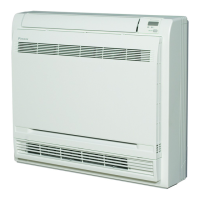
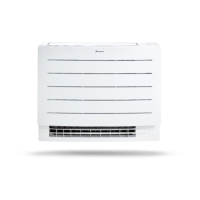
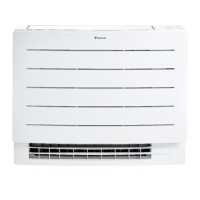

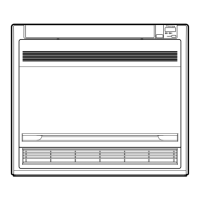

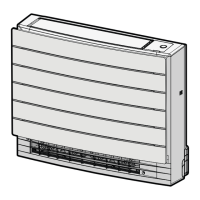





